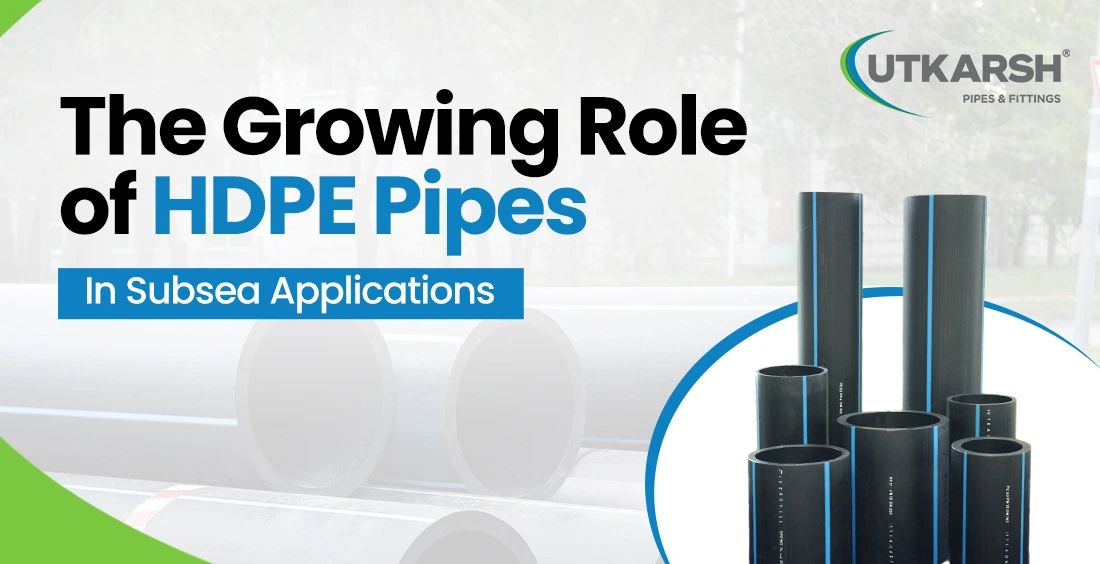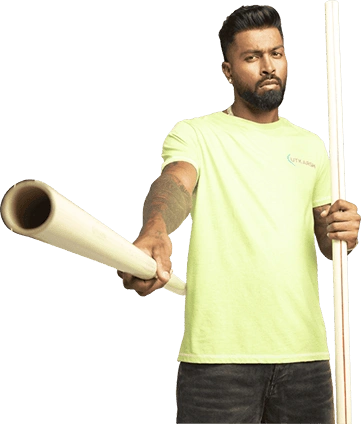The Growing Role of HDPE Pipes in Subsea Applications

Subsea pipeline installation is a cornerstone of modern marine infrastructure enabling industries like, oil and gas, desalination, and underwater utilities to function seamlessly. Among the various materials used in these projects, HDPE pipes have emerged as the preferred choice due to their unmatched strength, flexibility, and corrosion resistance. Today, the role of HDPE pipes in subsea applications is transforming how underwater pipeline systems are designed, deployed, and maintained.
As one of India’s leading HDPE pipes & fittings manufacturers, Utkarsh Pipes and Fittings is contributing to this transformation through precision engineering and innovation in marine piping solutions.
Understanding the Need for HDPE in Subsea Projects
In subsea environments, materials are constantly exposed to high pressure, temperature variations, and saline water, conditions that can degrade traditional metal or PVC pipelines over time. HDPE (High-Density Polyethylene) pipeline technology for subsea projects solves this challenge by offering a lightweight, durable, and chemically inert solution that withstands these demanding conditions.
Moreover, HDPE’s seamless fusion joints ensure leak-free connections, which are crucial for applications like marine plumbing, offshore oil transport, and underwater utility lines.
Why HDPE Pipes are Ideal for Underwater Pipeline Systems
1. Superior Corrosion and Chemical Resistance
Unlike metallic pipes that corrode in saline environments, HDPE pipes are naturally resistant to seawater and most industrial chemicals. This makes them ideal for marine piping systems that require long-term reliability and minimal maintenance.
2. High Flexibility and Impact Strength
During subsea pipeline installation, pipes often need to be laid over uneven sea floors or subjected to water currents. HDPE’s flexibility and impact resistance ensure that these pipelines maintain their shape and structural integrity under varying conditions, preventing cracks or fractures.
3. Lightweight and Easy to Install
HDPE’s low density simplifies transport, handling, and installation. Underwater pipelines made from HDPE can be floated into position before being submerged — significantly reducing the cost and time of subsea pipeline installation projects.
4. Leak-Free Jointing System
HDPE pipes are joined using heat fusion technology, creating a continuous, leak-proof pipeline. This method eliminates weak points commonly found in gasketed or flanged systems, ensuring maximum efficiency in underwater pipeline systems and marine plumbing operations.
5. Longevity and Sustainability
HDPE pipelines have an average service life exceeding 50 years. Their durability and recyclability also make them an eco-friendly alternative — an essential advantage for marine and offshore industries seeking sustainable infrastructure.
Applications of HDPE Pipeline Technology for Subsea Projects
The role of HDPE pipes in subsea sectors extends across diverse marine and offshore applications. Here are some of the most common uses:
Desalination Plants: Transporting seawater to and from desalination units efficiently and safely.
Marine Outfalls: Discharging treated effluents into the sea without environmental contamination.
Offshore Oil & Gas: Acting as conduits for transporting fluids or controlling systems in offshore rigs.
Port Infrastructure: Used in marine plumbing for firefighting, cooling, and water distribution systems.
Underwater Power Cables Protection: HDPE conduits shield sensitive electrical and communication cables from physical damage.
Each of these applications benefits from HDPE’s resilience, adaptability, and ease of fusion-based jointing, making it the go-to solution for underwater engineering projects worldwide.
Technical Edge: HDPE Pipeline Installation in Subsea Environments
A successful subsea pipeline installation demands precise engineering and adherence to international standards. Utkarsh’s advanced production facilities ensure that each HDPE pipe meets strict quality and dimensional accuracy parameters. The installation process typically includes:
Design and Planning: Mapping seabed contours and defining pipeline routes.
Prefabrication: Customizing HDPE sections for pressure, temperature, and chemical compatibility.
Fusion Welding: Using butt fusion or electrofusion methods to create monolithic pipelines.
Testing and Deployment: Pressure and leak testing prior to controlled submersion using flotation methods.
Anchoring and Stabilization: Securing the pipeline against ocean currents and seabed shifts.
The Future of Marine Piping: Innovation with HDPE
The global marine and offshore sectors are increasingly embracing HDPE pipeline technology for subsea projects. Innovations like smart monitoring systems, advanced fusion welding techniques, and modular installation methods are expanding the scope of HDPE use in subsea infrastructure.
With environmental regulations tightening worldwide, HDPE’s sustainability and cost-effectiveness further strengthen its position as the future of underwater pipeline systems.
Why Choose Utkarsh Pipes and Fittings for Subsea Projects
At Utkarsh Pipes and Fittings, we combine cutting-edge manufacturing technology with over five decades of expertise in fluid management solutions. Our HDPE pipes & fittings are designed to perform in the harshest subsea conditions, delivering unmatched reliability and operational efficiency.
Whether it’s marine outfall systems, offshore infrastructure, or industrial desalination projects, Utkarsh ensures each pipe adheres to international quality standards — empowering clients to build stronger, safer, and more sustainable marine networks.
Wrapping Up
The growing role of HDPE pipes in subsea applications marks a significant evolution in marine infrastructure development. Their strength, flexibility, and longevity have made them indispensable to underwater pipeline systems worldwide.
If you’re planning a subsea pipeline installation, partner with Utkarsh Pipes and Fittings — where innovation meets trust. Our advanced HDPE pipes & fittings are built to ensure lasting performance beneath the waves.
FAQs
Q1. What makes HDPE pipes ideal for subsea pipeline installation?
HDPE pipes are lightweight, corrosion-resistant, and flexible — allowing easy installation and long-term reliability under marine conditions.
Q2. How are HDPE pipes used in marine piping systems?
They are commonly used in seawater intake and outfall lines, desalination plants, and offshore utilities for fluid transport and drainage.
Q3. What is the lifespan of HDPE pipes in underwater pipeline systems?
With proper installation and maintenance, HDPE pipes can last over 50 years in subsea and marine environments.
Q4. Why choose Utkarsh Pipes and Fittings for HDPE subsea projects?
Utkarsh offers precision-engineered HDPE pipes & fittings tested for durability, strength, and compliance — ensuring superior performance in every subsea project.











